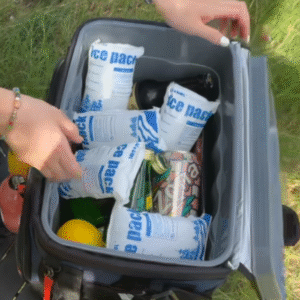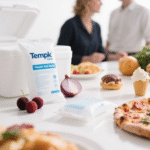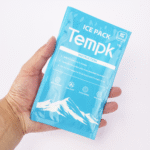Dry Ice Pack and Dry Ice Bricks Shipping: Optimizing Cold Chain Logistics in 2025
In der heutigen Kaltkette -Logistik, maintaining optimal temperatures is essential when shipping perishable goods such as seafood, Fleisch, Arzneimittel, und Impfstoffe. Trockeneis, in the form of either dry ice packs or dry ice bricks, provides an efficient and effective cooling solution for long-distance shipments. This article delves into the differences, Vorteile, and best practices for shipping with dry ice packs and bricks in 2025, focusing on maximizing efficiency and compliance with evolving regulations.
-
Was sind Trockeneisbeutel and dry ice bricks, Und wie funktionieren sie??
-
How do you calculate the right amount of dry ice for your shipment?
-
What are the best practices for shipping perishable goods using dry ice?
-
What safety measures must you follow when shipping with dry ice?
-
How do dry ice bricks compare to gel packs and other refrigerants?
What are Dry Ice Packs and Dry Ice Bricks?
Trockeneis ist festes Kohlendioxid (Co₂) that sublimates at an extremely low temperature of -78.5°C (-109.3° F). It is used to maintain frozen and chilled conditions for temperature-sensitive goods during transport. Dry ice packs and dry ice bricks, while both effective in cooling, serve different purposes depending on the shipping requirements.
Trockeneisbeutel
Dry ice packs are flexible, lightweight sheets that are often used for small to medium-sized shipments. They are typically filled with small pellets of dry ice and encased in materials like plastic or foam. Dry ice packs are ideal for short-duration shipping and can be easily arranged in packaging to fit various sizes.
Trockeneissteine
Trockeneisziegel, auf der anderen Seite, are large blocks of dry ice that offer a more concentrated cooling effect. These are ideal for longer shipments, providing extended cooling durations. The rigid form of dry ice bricks allows for more stable temperature control during longer journeys.
| Art von Trockeneis | Beschreibung | Idealer Anwendungsfall |
|---|---|---|
| Trockeneisbeutel | Flexibel, lightweight sheets | Small to medium shipments requiring flexibility |
| Trockeneissteine | Rigid blocks, langsamere Sublimation | Large shipments requiring extended cooling |
How Do Dry Ice Packs and Dry Ice Bricks Maintain Cold Temperatures During Shipping?
Dry ice achieves its cooling power through sublimation, where it transitions from solid to gas without becoming liquid. This process absorbs heat, effectively lowering the surrounding temperature.
Sublimation Process and Cooling
-
Trockeneisbeutel: Sublimate at -78.5°C, providing moderate cooling for 24 Zu 48 Std.. Their flexibility allows them to be easily distributed throughout the shipping container, maintaining consistent cold temperatures for smaller shipments.
-
Trockeneissteine: Sublimate at the same temperature, but their larger mass and solid form cause them to release CO₂ gas at a slower rate, allowing them to maintain cold temperatures for longer, making them ideal for shipments lasting up to 72 Stunden oder mehr.
| Dry Ice Type | Ideal Duration of Use | Ideal Shipment Type |
|---|---|---|
| Trockeneisbeutel | 24-48 Std. | Short-distance shipments, verderbliche Güter |
| Trockeneissteine | 72 Stunden oder mehr | Fernlieferungen, bulk products |
Best Practices für die Verwendung von Trockeneis bei der Schifffahrt
Richtige Verpackung
-
Isolierung: Use high-quality insulated boxes like Styrofoam or polyurethane foam to reduce heat transfer. Ensure the packaging allows for CO₂ gas to escape, as dry ice sublimates into gas.
-
Entlüftung: Dry ice must be packed in containers that allow the CO₂ gas to vent to avoid pressure buildup, which could lead to the rupture of packaging.
Calculating the Right Amount of Dry Ice
The quantity of dry ice required depends on factors such as the shipment’s duration, Die Qualität der Isolierung, und der Umgebungstemperatur während des Transports. In der Regel, for a 24-hour shipment, 0.5 kg of dry ice per kg of the product should be used. Für längere Dauer, increase the amount of dry ice by 1.5 times to account for sublimation rates.
Labeling and Documentation
Beim Versand mit Trockeneis, it’s crucial to comply with regulatory requirements:
-
Proper labeling with “Dry Ice” or “Carbon Dioxide, Solide"
-
UN1845 shipping number
-
Klasse 9 Hazard -Etikett
-
The net weight of dry ice in kilograms
These labeling requirements are essential for ensuring safe and compliant transport.
Safety and Regulatory Compliance for Dry Ice Shipping
Trockeneis wird als Gefahrstoff eingestuft (Klasse 9, UN1845) and requires adherence to specific shipping regulations. Compliance with IATA (Internationale Luftverkehrsvereinigung) und Punkt (Verkehrsministerium) guidelines is mandatory to ensure safe shipping.
Key Compliance Requirements:
-
Verpackung: Dry ice must be transported in vented packaging, such as corrugated cardboard boxes with foam insulation.
-
Dokumentation: Include a proper air waybill with the shipping details, including the weight of dry ice.
-
Handhabung: Always wear insulated gloves and safety goggles when handling dry ice to prevent injury from frostbite or eye exposure.
Trockeneis vs. Gelpackungen: Which Is Better for Your Shipment?
Dry ice is often compared to gel packs, especially for shipments that need to be chilled but not frozen. Jedoch, dry ice has several advantages for specific needs:
Trockeneis
-
Extrem niedrige Temperaturen: Dry ice can keep frozen goods solid, unlike gel packs, which are not designed for subzero temperatures.
-
Längere Dauer: Trockeneisziegel, insbesondere, provide longer cooling durations than gel packs.
Gelpackungen
-
Safer and Easier to Handle: Gelpakete sind ungiftig, wiederverwendbar, and require no special handling. Jedoch, they cannot achieve the ultra-low temperatures necessary for frozen goods.
-
Shorter Cooling Period: Gel packs are ideal for chilled items but not suitable for extended freezing.
| Kühlmethode | Idealer Anwendungsfall | Profis | Nachteile |
|---|---|---|---|
| Trockeneis | Gefrorene Lebensmittel, Biologika | Extrem niedrige Temperaturen, long duration | Erfordert eine besondere Handhabung, Vorschriftenregulierung |
| Gelpackungen | Frische Produkte, meals | Sicherer, wiederverwendbar, ungiftig | Limited temperature range, kürzere Dauer |
Environmental Impact and Sustainability of Dry Ice Shipping
In 2025, sustainability is a key concern in the cold chain logistics industry. Dry ice offers some environmental advantages but also has its drawbacks.
Pros of Dry Ice:
-
Reclaimed CO₂: Many suppliers produce dry ice from CO₂ captured during industrial processes, reducing emissions.
-
No Water Waste: Trockeneis untermauert direkt in Gas, leaving no water residue and reducing waste.
Herausforderungen:
-
CO₂ Release: Although CO₂ is reclaimed, it is released into the atmosphere during sublimation.
-
Energy Use: The production of dry ice requires energy, typically from non-renewable sources.
Sustainability trends include the use of biodegradable refrigerants, IoT-enabled temperature monitoring, and smart packaging solutions.
Häufig gestellte Fragen (FAQ)
Q1: Wie lange dauert Trockeis während des Versands??
Trockeneis dauert normalerweise dazwischen 18 Zu 72 Std., Abhängig vom Typ (pack or brick), Isolierung, und Umweltbedingungen.
Q2: Can dry ice be used for international shipments?
Ja, Trockeneis kann international versendet werden, but it must comply with international shipping regulations, including those set by IATA and DOT.
Q3: What are the safety precautions for shipping with dry ice?
Stellen Sie eine ordnungsgemäße Belüftung sicher, use appropriate protective gear, and comply with all labeling and documentation requirements.
Schlussfolgerung und Empfehlungen
Dry ice packs and dry ice bricks are vital for cold chain logistics, offering solutions for different shipment sizes, durations, and temperature requirements. By understanding the differences between these options, calculating the appropriate amount of dry ice, and adhering to safety and regulatory guidelines, businesses can ensure the safe and efficient transport of temperature-sensitive goods.
Nächste Schritte:
-
Konsultieren Sie Experten to choose the right dry ice solution.
-
Invest in high-quality packaging Verbesserung der Temperaturregelung.
-
Stay updated on regulations and sustainability trends to improve your cold chain logistics.
Über Tempk
Und Tempk, we specialize in providing cutting-edge cold chain logistics solutions, including dry ice packs and bricks. Our products ensure your goods remain safe and fresh during transport, with a focus on sustainability and regulatory compliance.
Aufruf zum Handeln: Contact Tempk today to discuss how our dry ice solutions can enhance your logistics operations.
























